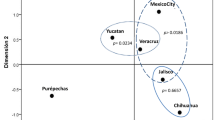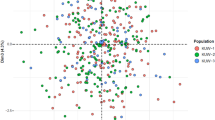Abstract
A two-locus match probability is presented that incorporates the effects of within-subpopulation inbreeding (consanguinity) in addition to population subdivision. The usual practice of calculating multi-locus match probabilities as the product of single-locus probabilities assumes independence between loci. There are a number of population genetics phenomena that can violate this assumption: in addition to consanguinity, which increases homozygosity at all loci simultaneously, gametic disequilibrium will introduce dependence into DNA profiles. However, in forensics the latter problem is usually addressed in part by the careful choice of unlinked loci. Hence, as is conventional, we assume gametic equilibrium here, and focus instead on between-locus dependence due to consanguinity. The resulting match probability formulae are an extension of existing methods in the literature, and are shown to be more conservative than these methods in the case of double homozygote matches. For two-locus profiles involving one or more heterozygous genotypes, results are similar to, or smaller than, the existing approaches.
Similar content being viewed by others
References
Ayres, K.L., 1998. Measuring genetic correlations within and between loci, with implications for disequilibrium mapping and forensic identification. PhD Thesis, The University of Reading.
Ayres, K.L. & D.J. Balding, 1998. Measuring departures from Hardy-Weinberg: A Markov chain Monte Carlo method for estimating the inbreeding coefficient. Heredity 80: 769–777.
Ayres, K.L. & A.D.J. Overall, 1999. Allowing for withinsubpopulation inbreeding in forensic match probabilities. Forensic Sci. Int. 103: 207–216.
Balding, D.J., M. Greenhalgh & R.A. Nichols, 1997. Population genetics of STR loci in Caucasians. Int. J. Legal Med. 108: 300– 305.
Balding, D.J. & R.A. Nichols, 1994. DNA profile match probability calculation: how to allow for population stratification, relatedness, database selection and single bands. Forensic Sci. Int. 64: 125–140.
Balding, D.J. & R.A. Nichols, 1995. A method for quantifying differentiation between populations at multi-allelic loci and its implications for investigating identity and paternity. Genetica 96: 3–12.
Cockerham, C.C., 1973. Analyses of gene frequencies. Genetics 74: 679–700.
Cockerham, C.C. & B.S. Weir, 1968. Sib mating with two linked loci. Genetics 60: 629–640.
Donnelly, P., 1995. Nonindependence of matches at different loci in DNA profiles: quantifying the effect of close relatives on the match probability. Heredity 75: 26–34.
Evett, I.W., P.D. Gill, J.K. Scranage & B.S. Weir, 1996. Establishing the robustness of Short-Tandem-Repeat statistics for forensic applications. Am. J. Hum. Genet. 58: 398–407.
Foreman, L.A., I.W. Evett & A.F.M. Smith, 1997. Bayesian analysis of deoxyribonucleic Acid profiling data in forensic identification applications (with discussion). J. Roy. Statist. Soc. A 160: 429–469.
Gamerman, D., 1997. Markov chain Monte Carlo. London: Chapman & Hall.
Hill, W.G., H.A. Babiker, L.C. Ranford-Cartwright & D. Walliker, 1995. Estimation of inbreeding coefficients from genotypic data on multiple alleles, and application to estimation of clonality in malaria parasites. Gen. Res. (Camb.) 65: 53–61.
Lander, E.S. & D. Botstein, 1987. Homozygosity mapping: A way to map human recessive traits with the DNA of inbred children. Science 236: 1567–1570.
National Research Council, 1996. The Evaluation of Forensic DNA Evidence. Washington, DC, National Academy Press.
Rannala, B. & J.A. Hartigan, 1996. Estimating gene flow in island populations. Gen. Res. (Camb.) 67: 147–158.
Shoemaker, J., I. Painter & B.S. Weir, 1998. A Bayesian characterization of Hardy–Weinberg disequilibrium. Genetics 149: 2079–2088.
Slatkin, M., 1985. Gene flow in natural populations. Ann. Rev. Ecol. Syst. 16: 393–430.
Zaykin, D., L.A. Zhivotovsky & B.S. Weir, 1995. Exact tests for association between alleles at arbitrary numbers of loci. Genetica 96: 169–178.
Author information
Authors and Affiliations
Rights and permissions
About this article
Cite this article
Ayres, K.L. A Two-Locus Forensic Match Probability for Subdivided Populations. Genetica 108, 137–143 (2000). https://doi.org/10.1023/A:1004152931349
Issue Date:
DOI: https://doi.org/10.1023/A:1004152931349




